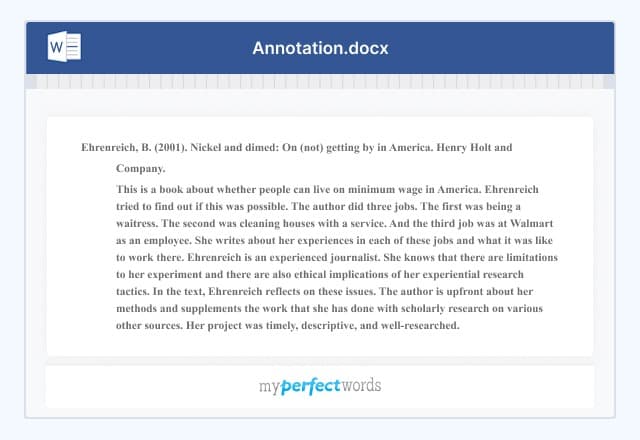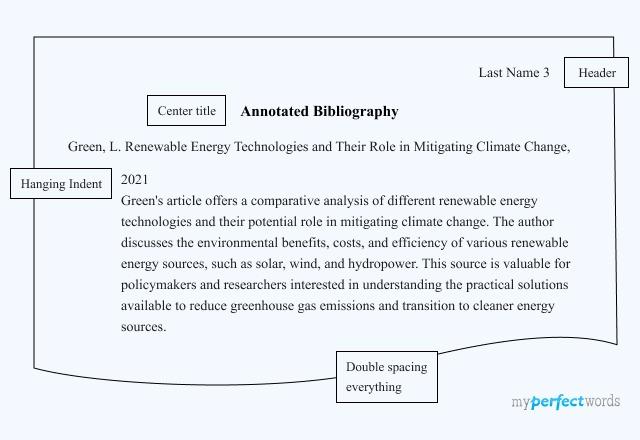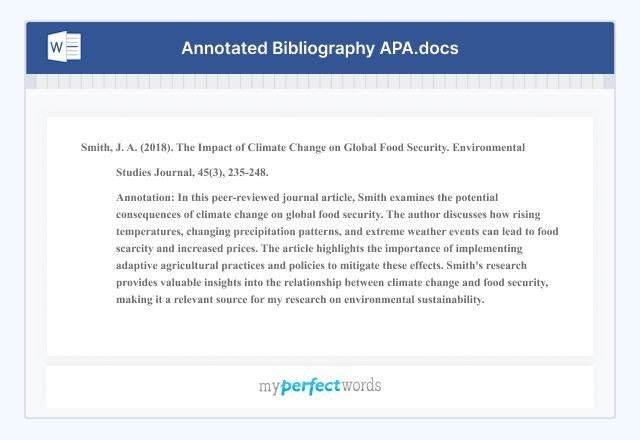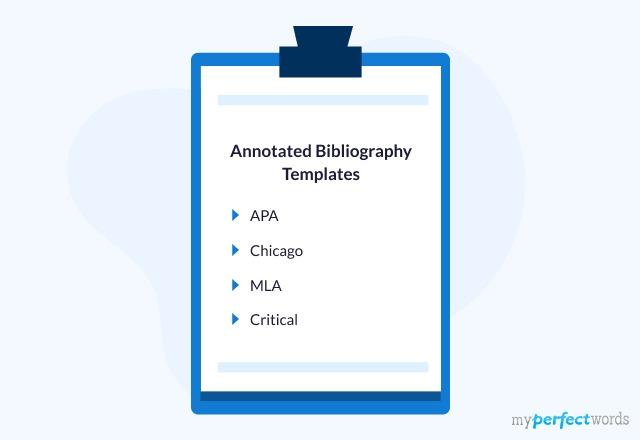Are you a research student in the initial stages of your research? If so, you'll likely encounter the annotated bibliography assignment.
An annotated bibliography is an important part of any research project. It provides a comprehensive overview of the sources you’ve gathered for a paper. It demonstrates the depth of your research and also how well you've explored your topic.
However, many students don't know how to write one. Are you one of them?
This comprehensive guide will help create an effective annotated bibliography step-by-step. Plus, you will find useful examples and helpful tips to enhance your work.
So let's dive in!
On This Page![]()
- 1. What is an Annotated Bibliography?
- 2. How to Write an Annotated Bibliography Step by Step?
- 3. Annotated Bibliography Examples
- 4. Abstract vs Annotation vs Literature Review: What’s the Difference?
- 5. Annotated Bibliography Topics
What is an Annotated Bibliography?
An annotated bibliography is an organized list of sources that includes a brief explanation and analysis of each source. Unlike a usual “works cited” page, it contains more detailed information about each individual source and how it relates to the research at hand.
Here is a short annotated bibliography definition:
“Annotated bibliography is a list of sources that contains a short description for each source”
The Purpose of Annotated Bibliography
An annotation is an evaluation or summary of the given reference. Based on what you are writing, an annotated bibliography can do the following:
- Summarize - Some annotations only summarize the article or book. What arguments does this article have? What is the point of this book? What topics are covered in this article?
- Assess - Annotations can assess how useful the source is from your point of view. Is it a credible source? Does it have any bias or distortion in the information? What do other sources say about this topic?
- Reflect - Moreover, you can discuss how a source helps with your research. For example, does the source help you shape an argument? Does it change the way you think about your topic?
Components of an Annotated Bibliography
In an annotated bibliography, each reference entry includes two parts, citation and annotation.
- Citations
Citations in an annotated bibliography provide the essential details about each source. These details typically include the author's name, title, publication date, source type (e.g., book, article, website), and the source's publication information.
It demands an accurate and consistent citation style to ensure that your readers can locate and verify the sources you've used. The specific format for these elements varies according to the chosen citation style (e.g., APA, MLA, Chicago).
For instance, here’s a citation in MLA style:
Wood, Levison. The Art of Exploration: Lessons in Curiosity, Leadership and Getting Things Done. Hodder & Stoughton, 2021. |
- Annotations
Annotations, on the other hand, are brief summaries and evaluations of each source. They offer insight into the source's content, methodology, and relevance to your research. Each annotation can be about 150-250 words.
Here’s a sample annotation to the source cited above.
This book is a memoir and a guide by Levison Wood, a British explorer, writer, and photographer who has traveled to over 100 countries and walked the length of the Nile, the Himalayas, and Central America. Wood shares his insights and experiences on how to explore the world, overcome challenges, and achieve goals. He also offers practical advice on topics such as planning, preparation, leadership, teamwork, risk management, and resilience. The book is divided into three parts: The Explorer's Mindset, The Explorer's Toolkit, and The Explorer's Journey. Each part contains several chapters that illustrate Wood's principles and stories with examples from his own adventures and those of other famous explorers. The book is written in a conversational and engaging style, with humor, anecdotes, and vivid descriptions. The book provides useful information and tips for aspiring or experienced explorers who want to improve their skills and knowledge. It is based on Wood's extensive research and first-hand experience, and reflects his passion and expertise in the field of exploration. |
You can watch this video to learn more about annotated bibliographies:
How to Write an Annotated Bibliography Step by Step?
Now that you’re familiar with the basics of the annotated bibliography, let’s move on to how to write it. Here are the steps involved in creating an annotated bibliography.
Step 1: Select the Sources
The very first step is to select the sources related to your topic. Go for research papers, books, or articles that you would probably use for your academic paper.
‘How many sources should I add in an annotated bibliography?’
For a full-fledged research project, you have to pick at least 15-20 sources for your annotated bibliography. However, the actual number depends on your topic, your academic level, your teacher’s instructions, and the depth of your research.
If you are writing a three-page research essay, it would be safe to pick 4-5 sources for your annotated bibliography. In addition, you should always ask for your professor’s instructions and preferences.
Step 2: Read the Selected Material
Once you've gathered your sources, it's time to dive into them. Read each source thoroughly, taking notes as you go.
You'll need a good understanding of the source's main arguments, evidence, and any key points. This knowledge will help you write meaningful annotations.
Step 3: Know the Required Citation Style
Now before you start writing your annotations, you should know the citation style you are required to use. You need to cite your sources accurately according to a specific format.
Different academic disciplines often require specific citation styles, such as APA, MLA, Chicago, or Harvard. Be sure to know which style your assignment demands and stick to it consistently throughout your annotated bibliography.
Step 4: Choose the Type of Annotated Bibliography
There are 3 main types of annotated bibliographies. All of these types have distinct features, and knowing about them will help you understand your teacher’s instructions in a better manner.
Here are the types of annotated bibliographies you could write:
Descriptive Annotated Bibliography
Descriptive (also known as Indicative) annotated bibliography provides a brief summary and explanation of a given citation or reference.
It includes:
- Main theme and content of the citation
- A brief summary of the main points
This type of annotated bibliography is quite simple and takes less time to write and create. Here’s an example of a descriptive annotation:
Waltz, K. (1959). Man, The State, and War. Columbia University Press. Kenneth Waltz's "Man, The State, and War" is a seminal work in international relations that explores the fundamental causes of war. Published in 1959, Waltz addresses the classical theories of war—those centered around the individual, the state, and the international system. The main theme revolves around the idea that war is a result of human nature, state structures, or the anarchic nature of the international system. In a concise and systematic manner, Waltz critiques these perspectives and introduces the notion of "levels of analysis," arguing that the causes of war should be examined at different levels. The book offers a comprehensive overview of the major theories in the field, providing readers with a deep understanding of the complexities surrounding the origins of conflict. |
Evaluative Annotated Bibliography
An evaluative bibliography aims to assess the sources based on some criteria. It provides a detailed analysis and includes your critical judgment and opinions about the work.
This kind of annotation starts with discussing the main focus and theme of the citation and moves on to more in-depth details. As a final word, you add your personal views regarding the source material.
Here are some important points that you should cover in an evaluative annotated bibliography:
- How does the source compare with other works and research?
- What are the strong and weak points of the study?
- How accurate or biased is the information or conclusions presented in it?
- How useful is it for your essay and research paper?
Here’s an evaluative annotation for the same source used above:
Waltz, K. (1959). Man, The State, and War. Columbia University Press. Waltz's contribution is significant due to its systematic critique of traditional theories and the introduction of the "levels of analysis" framework. This approach, evaluating the causes of war at individual, state, and international levels, adds depth and nuance to the discourse. The strength of the book lies in its comprehensive coverage of major theories, enabling readers to grasp the intricacies of international relations perspectives. However, the book's weaknesses include a somewhat dated context, given its original publication in 1959. While the fundamental theories remain relevant, the geopolitical landscape has evolved, warranting consideration of more recent developments. Additionally, Waltz's approach, while groundbreaking, has been subject to criticism for oversimplification. Still, Its analytical depth and historical significance make it a cornerstone in the study of international relations. Its utility extends beyond mere academic exploration, offering a framework that encourages critical thinking about the complexities of war and state interactions. |
Combination Annotated Bibliography
Most of the annotated bibliographies are a combination of the two main types. These are known as combination annotated bibliographies.
This is the most common type that is used across academic disciplines and levels. So if your professor has not mentioned or clarified the type of annotated bibliography.
In this type, you include both the descriptive and the evaluative parts in your annotations. That is, the first part of the annotation describes the source factually and objectively, while the second part consists of your subjective assessments.
Here’s a combination annotation example:
Waltz, K. (1959). Man, The State, and War. Columbia University Press. Kenneth Waltz's "Man, The State, and War" is a seminal work in international relations that explores the fundamental causes of war. Published in 1959, the book critically assesses classical theories of war centered around the individual, the state, and the international system. Waltz introduces the innovative notion of "levels of analysis," arguing that these causes should be examined at different levels, thereby broadening the scholarly approach to understanding conflict origins. In comparing this source with others in the field, Waltz's contribution is remarkable, providing a systematic critique of traditional theories and offering a nuanced framework for evaluating the causes of war. The book's strength lies in its comprehensive coverage of major theories, facilitating a deep understanding of the complexities surrounding international relations perspectives. Despite its significance, weaknesses are apparent. The book's historical context may limit its applicability to contemporary geopolitical landscapes, and its approach has faced criticism for oversimplification. |
With the above 4 steps, you’ve got everything you need to prepare an annotated bibliography. So now it’s finally time to write it.
Step 5: Write Your Annotations
An annotated bibliography entry has two parts: citation and annotation. The citation is the reference that you will explain in the following part, and the annotation is the explanation and analysis of the given citation.
Here’s how to write both the parts:
Citation
The citation part is where you write the reference to the source. You need to write the citation as per the paper’s chosen citation style, which can be MLA, APA, or others.
Although citation styles differ in what to include in the reference, here are some common elements included in all citations:
- Full name of the works, i.e., book, article, etc.
- Names of the authors who contributed to the work
- Name of the publisher
- Date when the work was published
- Date when you accessed the source
The sequence of the details will vary according to the formats. For example, here is a citation written according to the APA:
Lhachimi, S.K., and Cole, K.J. (2015) Health impacts of increasing alcohol prices in the European Union: A dynamic projection. Preventive Medicine. 55(3), pp.237-243. |
Annotation
Annotation is the detailed description of the source that comes after the citation. A combination annotation consists of four essential parts, which are:
- Summary
This section will include the summarized details of the data, arguments, facts, or findings presented by the author(s) in their research work. Be careful about the length of this part; it should be half of the length of the entire annotation.
- Evaluation
After providing summarized information, you will evaluate the claims, arguments, and findings of the author in this section. Explain what you have learned from the respective source and explain how it is relevant to your research.
- Reflection
The last part of the annotation, as well as the annotated bibliography, is the description of the relevance of the selected source. How well is it relevant to your research? How has it helped your research? What new information has it added to your paper?
Here is an example of a 150-word combination annotation:
Lhachimi, S.K., and Cole, K.J. (2015) Health impacts of increasing alcohol prices in the European Union: A dynamic projection. Preventive Medicine. 55(3), pp.237-243. | |
Summary | This research looks at the health impact of alcohol and whether increasing the price would affect its consumption. The quantitative methodology uses alcohol consumption and disease data to plot changes in the health of the population. The authors conclude that increasing the price of alcohol would reduce significant numbers of alcohol-related deaths and lead to a reduction in chronic diseases. Therefore, reducing excessive drinking could result in significant gains in the health of the general population. |
Evaluation/Assessment | The article appears to be written to inform health professionals who work with alcohol-dependent people. The data presented by the authors is informative. However, the data collection method could be considered flawed due to the small sample groups. The research also appears to be predictive and, therefore, may be considered biased. |
Reflection | The results and conclusions could be used by health professionals to inform the general public of the benefits of raising the price of alcohol using the data presented. |
Step 6: Arrange Your Annotated Bibliography
You've done the hard work of selecting sources, reading them, and creating annotations. Now, it's time to organize your annotated bibliography.
Here's how to do it effectively:
- Alphabetical Order: The most common way to arrange your annotated bibliography is in alphabetical order by the author's last name. If there's no author, you can use the title.
- Consistent Format: Ensure that your citation and annotation follow the same format throughout the bibliography.
- Follow Your Instructor's Guidelines: Adhere to any specific formatting or organizational requirements provided by your instructor or institution.
Step 7: Review and Revise
Before you consider your work done, it's essential to take a moment for a final review and revision.
- Review your annotations for clarity and conciseness, ensuring they provide a clear summary and evaluation of each source.
- Double-check the relevance of each source to your research topic, and maintain consistency in annotation length for a uniform appearance.
- Seek feedback from peers and professors so you can get fresh perspectives and valuable suggestions for improvement.
- Give a final proofread for grammar and spelling errors to ensure a polished and credible end result.
Annotated Bibliography Examples
You may now be wondering, “what does an annotated bibliography look like?”. Here is an annotated bibliography sample for you to check out.
Here are some sample annotations in different citation styles to help you understand the difference.
Annotated Bibliography - MLA 9th Style
Here’s an example of an annotation of a journal article according to the 9th edition of the MLA handbook:
Waite, Linda J., et al. "Nonfamily Living and the Erosion of Traditional Family Orientations Among Young Adults." American Sociological Review, vol. 51, no. 4, 1986, pp. 541-554. |
The authors are from the Rand Corporation and Brown University. They use data from a survey to see if people who live with other people or not their family have different attitudes, values, plans, and expectations than those who live with their family. The researchers found that their hypothesis was supported in young females, but not so much for young males. Living away from family might affect how you think about sex roles. People who live away from their families are more independent and self-sufficient. They also have different views on families. In contrast, Williams' study found no difference in gender attitudes because of living away from the family home. |
Here’s how you write an annotation of a book according to the Modern Language Association style:
Lamott, Anne. Bird by Bird: Some Instructions on Writing and Life. Anchor Books, 1995. |
Lamott's book provides an insightful look into the realities of a writing life, exploring topics such as plot development, jealousy, perfectionism, and internal criticism. By taking a humorous approach to these issues, Lamott offers practical advice for overcoming insecurities and failures with writing. Furthermore, she offers several writing exercises designed to be both productive and enjoyable. This text is invaluable in that it provides an honest perspective on the writing, publishing, and human process with its wry anecdotes and encouraging message. Such topics discussed within this book could easily be applied to a writing curriculum. Even so, among different books that discuss writing, this presents practical advice rather than an analysis of the writing process. Students should find Lamott's approach both thought-provoking and enjoyable. |
Here is a template for your annotated bibliography in MLA format;
Annotated Bibliography Examples APA 7th Edition
Here is an annotation written according to the 7th publication manual of the American Psychological Association, simply known as the APA format.
Ehrenreich, B. (2001). Nickel and dimed: On (not) getting by in America. Henry Holt and Company. |
This is a book about whether people can live on minimum wage in America. Ehrenreich tried to find out if this was possible. The author did three jobs. The first was being a waitress. The second was cleaning houses with a service. And the third job was at Walmart as an employee. She writes about her experiences in each of these jobs and what it was like to work there. Ehrenreich is an experienced journalist. She knows that there are limitations to her experiment and there are also ethical implications of her experiential research tactics. In the text, Ehrenreich reflects on these issues. The author is upfront about her methods and supplements the work that she has done with scholarly research on various other sources. Her project was timely, descriptive, and well-researched. |
Here is another APA annotated bibliography formatting example, this time of a journal article:
Nkwe, N. (2012). E-government: challenges and opportunities in Botswana. International journal of humanities and social science, 2(17), 39-48. |
In this journal article, the author attempted to explore the obstacles of e-government implementation in Botswana, as well as highlight opportunities for the country to move towards e-government. The author provided an in-depth exploration and study of Botswana's published e-government vision and strategy along with a comprehensive review of related literature. This research highlights that Botswana is yet to make much progress in using information and communication technologies for providing government services online. The study concludes that acknowledging the current state of e-government in Botswana may be advantageous for government officials as it can support the development of public entities, while also promoting economic growth. |
Annotated Bibliography Chicago Style Example
Davidson, Hilda Ellis. Roles of the Northern Goddess. London: Routledge, 1998. |
In his book, Davidson explores the many facets of Northern European pagan goddesses. From their pivotal roles in hunting to those played out inside homes and even death, he paints a vivid picture that captures how these powerful female figures were integral parts of everyday life for people living centuries ago. The book explores the ancient world through archaeological evidence, patterns in symbols, and rituals from previous research. It includes valuable black-and-white photos to illustrate the author's point. |
Here is a Chicago-style annotated bibliography template:
Need more topic ideas for your annotated bibliography? Check out this blog with a list of annotated bibliography topics.
Abstract vs Annotation vs Literature Review: What’s the Difference?
When it comes to academic writing, especially in the context of research projects, the terms "abstract," "annotation," and "literature review" often appear. Each serves a distinct purpose in scholarly communication.
Let's break down the key differences between these three elements:
Abstract
An abstract is a concise summary of a research paper or article. It's typically found at the beginning of a scholarly work and provides a brief overview of the study's objectives, methods, results, and conclusions. The primary aim of an abstract is to help readers quickly grasp the paper's essential points.
Annotation
Annotations are concise evaluations of individual sources. They provide an overview of the source's content and assess its quality, relevance, and significance to a specific research topic. Annotations are typically used within annotated bibliographies to guide the reader's understanding of each source's content and its potential contribution to the research project.
Literature Review
A literature review, on the other hand, is a comprehensive and critical examination of existing research on a specific topic. It involves synthesizing and analyzing a range of sources to identify patterns, gaps, and debates within the literature. A literature review explores the body of work related to a particular subject, offering a broader context for a research project.
Here are the differences between a literature review and an annotated bibliography.
Annotated Bibliography | Literature Review | |
Purpose | This is a list of sources that have more information about each source. Also, informs the readers about the credibility of each source. | This is an overview of the topic. It talks about the most important points discussed in the paper or work. It is added before the research section. |
Structure and Format | Sources are arranged alphabetically and separate from each other. | Sources are arranged in paragraphs and could be integrated also. |
Parts and Components | The parts include the citation, short summary, analysis, and personal views. | It begins with the introduction, analyzes the source’s content, and concludes it. |
Annotated Bibliography Topics
If you are set to write your annotated bibliography, the following are some topics that might help:
- Thesis based Masters is more beneficial than coursework based. Discuss the statement.
- Water pollution is damaging marine life. How true is the statement?
- Eating alkaline foods is more beneficial for the human body.
- Strengthening our immune system is the best way of fighting off diseases.
- Crash dieting is the reason for a number of health issues in teenagers and young adults.
- Reading helps our brains to improve and develop. Discuss.
- Pros and cons of taking writing as a profession.
- Role reversal is one of the significant themes in gender studies. Discuss.
- Investing in education and healthcare is optimal for a nation's development.
- Role of cottage industries in the improvement of the economy.
Need more topic ideas for your annotated bibliography? Check out this blog with a list of annotated bibliography topics.
To sum up,
Writing an annotated bibliography could be a challenging task for many students. It is detail-oriented, and you are expected to explain your sources meticulously. However, with the steps, explanations, and samples provided above, you are now ready to craft an excellent annotated bibliography.
Remember, the trick is to focus on a single annotation at a time. Write your annotations as best as you can, and leave the formatting part for the end. This way, you can ensure that everything is properly written and formatted in the final draft of your work.
If you are having any difficulties, get help from the online essay service that can solve all your writing worries!
We have years of experience delivering bibliographies to students like you. Whether it be APA, MLA, or any other citation style you need, our team can cite your sources properly and accurately.

Write Essay Within 60 Seconds!
Use our AI tool to generate high quality essay
WRITTEN BY
Caleb S.
Caleb S. has been providing writing services for over five years and has a Masters degree from Oxford University. He is an expert in his craft and takes great pride in helping students achieve their academic goals. Caleb is a dedicated professional who always puts his clients first.







